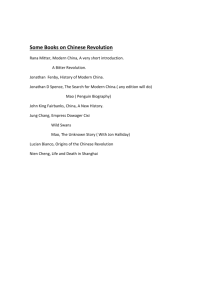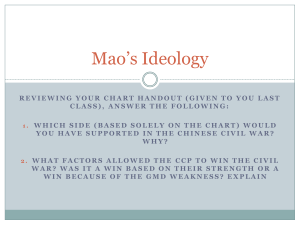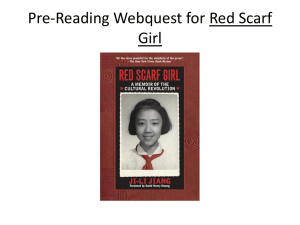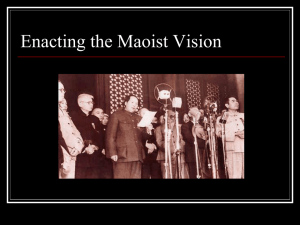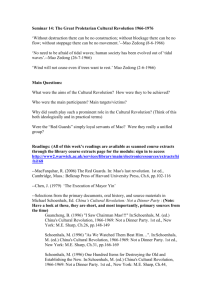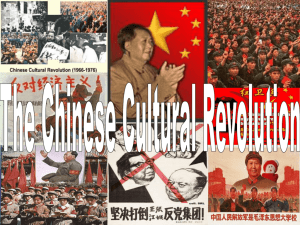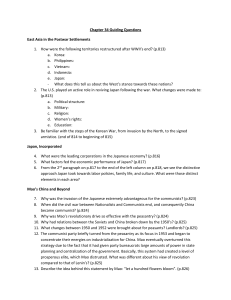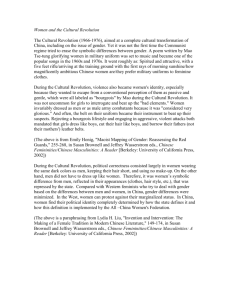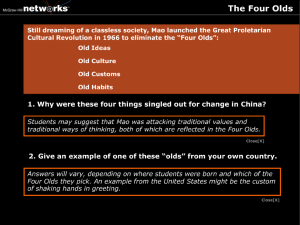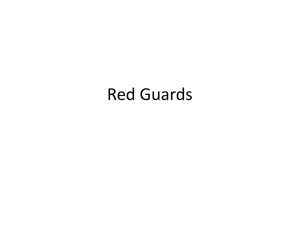Cultural Revolution
advertisement
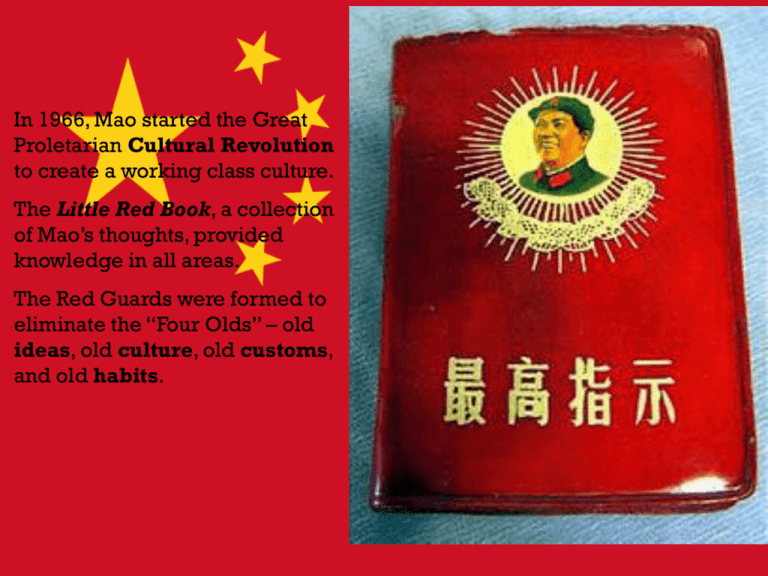
In 1966, Mao started the Great Proletarian Cultural Revolution to create a working class culture. The Little Red Book, a collection of Mao’s thoughts, provided knowledge in all areas. The Red Guards were formed to eliminate the “Four Olds” – old ideas, old culture, old customs, and old habits. The Cultural Revolution • After ending the Great Leap Forward, Mao was worried that the communist spirit was being thwarted by the desire to make money. • He concluded that China needed a cultural revolution to get rid of the Four Olds: old ideas, old culture, old customs, and old habits. The Cultural Revolution • Many Communist leaders disagreed with this plan to reverse economic recovery, so Mao turned to the young people to lead the revolution and created the Red Guards. The Red Guards • The Red Guards were mostly high school and college age students who sought to get rid of enemies of the state: city dwellers, corrupt communist officials, highly educated people, or anyone who associated with the Four Olds. • They traveled all over the country wreaking havoc, even the military was given orders not to stop them. • Within two years, China was on the brink of anarchy and no one was safe from the Red Guards. • In 1969, Mao recognized the excesses of the Red Guards and called them to disband. The military was allowed to impose order and law (finally). Chinese cultural revolution • Began in 1966 and lasted until 1976 • Mao thought that the reforms were too much, and so he created the Red Guard and the Cultural Revolution • Lead by the youth of China – The Red Guard was almost completely lead by students your age Chinese Cultural Revolution • The point of the revolution was to create a society where peasants and workers were all equal – They didn’t like intellectuals or artists because they were considered useless and dangerous. – They shut down colleges and schools – They targeted professors and teachers, government officials, factory managers, and even their own parents • Eventually Mao said that it was too much, and called for an end. Summary Cultural Revolution • 1968-1978 • Mao steps back to the front • Goals: Remove all elements of western ideas (books, music, ideas) & purge CCP of rivals • Mao sends Red Guard to enforce “True Chinese Communism” • Red Guard: squads of students given power to beat, humiliate anyone too westernized, intellectual, or “old fashioned” • Result: Political, economic, social chaos. Mao puts down Red Guard, gives up power. Red Scarf Girl by Ji Li Jian • Story about a girl who lived through the Chinese Cultural Revolution Memoirs 1 • “As we entered the apartment, I smelled smoke and started choking. I looked around in alarm. But Grandma was sitting alone in the main room, showing no sign of worry. ‘Grandma, is there a fire?’ we shouted anxiously. ‘Don’t you smell the smoke?’ ‘Hush Hush!’ Grandma said. ‘It’s nothing. They’re just burning some pictures. Your mother heard today that photos of people in old-fashioned long gowns and mandarin jackets are considered part of the old world. So your parents are burning them in the bathroom.” Memoirs 2 • “Xiao-cheng’s father had been our District Superintendent. Now he was suspended and under investigation for being a capitalist follower. Ming-ming’s father had been the Party Secretary of the Shanghai Institute of Political Science and law, and had been under arrest at the Institute for several weeks. He had been accused of being a traitor. Memoirs 3 • “At least he was still alive. At least he was still able to work. He wasn’t lying on the floor, bruised and cut from beatings, as Grandma had imagined… ‘You saw your father,’ [the guard said] ‘He is being remolded through labor. We have evidence that he has committed a serious counterrevolutionary crime. But he is very stubborn and refuses to confess. And your mother. Humph. She’s another despicable thing!”
